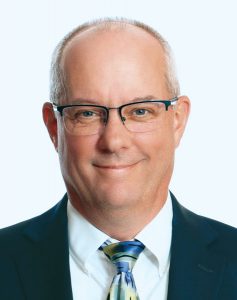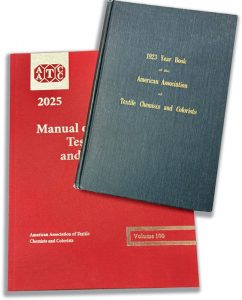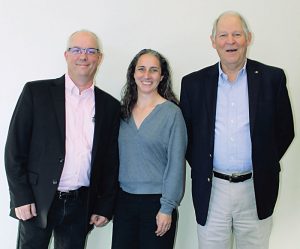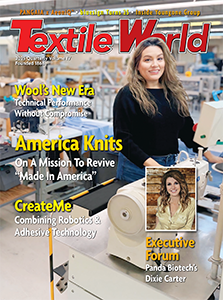
The American Association of Textile Chemists and Colorists’ (AATCC’s) Executive Director Gregg Woodcock discusses his personal textile journey, industry relationships and new leadership role at AATCC.
By James M. Borneman, Editor In Chief
In response to the World War I blockade of Germany, when the export of European dyes to the United states halted, 140 men gathered at the Engineer’s Club in Boston in 1921 and established the American Association of Textile Chemists and Colorists (AATCC). Its critical mission at that time was to develop standards for producing dye products consistently — which was urgently needed — and in doing so, the groundwork was laid for further development of test methods, evaluation procedures and literature that brought a semblance of order to the expanding dyeing and finishing industry.
For many in the textile industry, AATCC is a trusted resource for standardized textile test methods, training, publications, and engagement with like-minded industry professionals. AATCC standards became the arbiter for how textile manufacturers met the specifications of products ordered by their clients. Imagine the newfound ability for client and manufacturer to converse, compare competitive sources, and have a “standard”by which to evaluate order fulfillment.
Even today, when textile products are at the end of production, prior to shipping, or received by the next client downstream in the supply chain, AATCC standardized test methods provide a baseline that, technically and systematically, represent the product’s characteristics.
Late last year, AATCC named Gregg Woodcock executive director of the association — an organization that has played a significant role in his life-long career in textiles. Woodcock’s experience ranges from earning his textile engineering degree in 1985 to his most recent role as senior manager, Product Quality/Safety at Hanesbrands Inc.
Woodcock recently sat down with Textile World to share some of the challenges and insights gained throughout his textile career and how those experiences prepared him for his current responsibilities as AATCC executive director.
TW: What attracted you to the textile industry?
Woodcock: My father, Dr. Harry W. Woodcock, is a theoretical physicist who spent his entire career teaching at the Philadelphia College of Textiles and Science (PCT&S) which is now Thomas Jefferson University. As the dependent of a college professor, I had the opportunity to not pay tuition to attend the college.
As a curious student, following my junior year of high school I participated in a week-long summer textile camp at PCT&S, and I was hooked. The combination of zero tuition and the new-found interest in textiles led me to major in textile engineering.
TW: How did your academic background — a degree in textile engineering as well as a master’s degree from the Institute of Textile Technology —impact your career in textiles?
Woodcock: As with most college students, I thought I knew everything after receiving my undergraduate degree. I quickly learned in graduate school that I didn’t know what I didn’t know. I’ve carried that lesson with me throughout my career in industry, and now at AATCC.
Even after 60 years of living and learning, I learn new things every day. I spent the first decade of my career largely working in dyeing and finishing mills. My education made the work lessons easier to comprehend and work taught me a depth of knowledge that you can’t get from textbooks.
The degrees also taught me the language of textiles. Having the language and the engineering perspective allowed me to problem solve with a larger group of coworkers than if I had studied something other than textiles.

TW: What was your early career path like in textiles?
Woodcock: Probably the most significant detail of my early career was change. Over the first 11 years, I built three houses across North Carolina, moving multiple times.
A key lesson was to never burn bridges; you never know what the future holds. I left a particular dyeing and finishing mill, was gone for three years, and then came back in a higher-level position.
By leaving the first time with the right attitude, I was welcomed back. And one of the people that worked with me at that mill today works at AATCC.
TW: During your career, what impact did AATCC have on you, your work and your personal growth?
Woodcock: Back in college, AATCC was a legendary organization; there was a real mystique about it. There were so many critically important test methods that came from AATCC. For a large chunk of my career, I was responsible for product quality, including testing; it was during this stage that my relationship with AATCC really took off.
I joined AATCC as a member and became involved with multiple research committees
and eventually became chair of RA88, Home Laundering Technology, which then led
me to be a member of ECR — the Executive Committee on Research.
These were excellent experiences that broadened my personal knowledge, benefited the company that I worked for, and helped me make new connections across the industry.
Not long after my term on ECR ended, I became interested in growing my relationship with AATCC, examining different paths. Before anything concrete happened, the executive director role at AATCC opened up and here I am.
TW: When you came on board as AATCC’s executive director, what surprised you the most about the association and was there anything you learned about AATCC that you didn’t know?
Woodcock: Having been an active member for more than a dozen years, I knew about the comradery among the members. But I wasn’t fully aware of the staff at the AATCC Technical Center. They are an incredible group of people that do a tremendous amount of work for the association, often behind the scenes. They are highly talented and dedicated professionals. They feel like a “work family.”
I “knew”of the AATCC Foundation, but I wasn’t fully aware of it. It’s an incredible part of AATCC that just does one thing: it gives money to students in pursuit of textile education.
Each year, the foundation gives up to $132,000 in scholarships, fellowships, and research grants. Signing the checks for these gifts is the highlight of my year.
I’m tremendously grateful for the generous members that have built the foundation, including Charles E. Gavin III, who was instrumental in founding the scholarship program and gave the first financial gift to the foundation.
TW: Anything interesting that people may not know about AATCC?
Woodcock: I know this might sound funny, but AATCC 1993 Standard Reference Detergent, WOB – without optical brightener, is not made by the same company that makes the number one selling laundry detergent in the United States. I feel like I’ve been given the formula to Coca-Cola or Colonel Sander’s 11 herbs and spices.
What really differentiates AATCC detergent is its consistency — it doesn’t change with the times. The same is NOT true for detergents sold at retail. Lab testing demands consistency over time and AATCC detergent delivers consistency.

TW: When you are asked,“What is the AATCC?” what is your response?
Woodcock: I asked myself that question shortly after I arrived. I put a one-page document together to help me fully understand. Key points are:
- A professional association of members, including professionals, students, and corporations;
- Founded in 1921 to serve the global textile industry;
- A 501(c)(6) nonprofit organization;
- Focuses on textile testing methods, standards, and education for the textile, apparel, and related industries;
- Publishes the AATCC Technical Manual
(Manual of International Test Methods and Procedures), which includes test methods widely used for textile quality control; - Publishes the AATCC Journal of Research, a peer-reviewed scholarly journal. The journal’s aim is to advance and disseminate knowledge in all areas pertinent to textile research;
- Provides training, conferences, and networking opportunities for professionals in the field; and
- Includes the AATCC Foundation, a 501(c)(3) nonprofit organization that provides scholar-ships, fellowships, and research grants to undergraduate and graduate students studying textiles in the United States.
TW: AATCC has always been a gold standard for test methods and communication by way of the standards. What is the process like for developing standards, and how does AATCC understand the need for a new standard and develop a method to support it?
Woodcock: From my earliest days at PCT&S, to today, AATCC really has been the gold standard for textile test methods. And the secret sauce to the process of developing new standards and supporting existing standards is our members.
AATCC is made up a very diverse group of individuals that represent all facets of the textile supply chain. We have people that span the entire vertical, from fiber formation to textile manufacturing through cut/sew, to brands and retailers. Then there are academics and suppliers, who are absolutely critical to the long-term success of AATCC and the standards development process.
AATCC has dozens of research committees, all made up of members. The research committees meet twice a year — in May and November —and work on new test methods and update existing test methods.
Committee members are welcome to propose new test methods that will benefit the industry. Each committee is chaired by a member — not by AATCC staff — and each committee is made up of volunteer members of the association.
And the best part is that the committee meetings are free-of-charge to attend, and — thanks to COVID — offer a hybrid option.
TW: Education has always been an important part of AATCC, how has that evolved from when you were a student? How do you see it changing with the shifts in the textile industry?
Woodcock: The biggest change in textile education over the last few decades has been the reduction in the number of colleges dedicated to textiles in the country. There are still plenty of schools to obtain a degree in textiles but only one school/college of textiles remains.
Along with this change, the most common degrees have changed as well. There used to be a lot more textile chemists, textile engineers and textile technologists. Today, it’s textile/apparel design, textile/fashion merchandising, fashion management, and fashion and apparel studies, for example.
This changes some of the scholarships that the AATCC Foundation offers; two of the more recent scholarships added to the annual offering are a Textile Design Scholarship and a Textile Merchandising Scholarship.
A changing industry also impacts the educational classes that AATCC conducts; we now include a Mastering Textile Specifications workshop that is less technical than traditional offerings, but appeals more to designers, merchandisers, and product developers.
Though we have “chemists and colorists” in our name, we are adapting to the changes in industry and academia.
TW: Industry events and meetings have always been a large part of the organization. How are they structured today? Are certain types of meetings, conferences or digital options shifting in importance?
Woodcock: Industry associations are an important part of every industry. Since COVID, corporate travel budgets have been under more pressure than ever. Remote options have a real place that should not be abandoned, but so does face-to-face human interaction.
The relationships and camaraderie are enhanced by participating in industry events. Because of the stress on travel budgets, a collective of textile industry associations has been organized to help all the associations thrive. It’s called the Alphabet Soup Collective. It now includes 12 different organizations that meet regularly to discuss shared issues and seek out opportunities for collaboration.
To further the collaboration, AATCC and SEAMS — the Association and Voice of the U.S. Sewn Products Industry — are jointly hosting a fall meeting we are calling
“Fabricating the Future. ”It will be held in Savannah, Ga., October 5-7, 2025. There is a tremendous amount of content packed into the event that will appeal to both textile and apparel experts, plus plenty of opportunity to network and expand horizons.
TW: As executive director, what is your vision for AATCC and how is the vision impacted by the global textile industry?
Woodcock: For more than 100 years, AATCC has been a consistent beacon of service to the textile industry. Though founded in the United States and knowing that the first word in our name is “American”, we have become and will continue to be more international.
The AATCC Technical Manual is now the AATCC Manual of International Test Methods and Procedures.
In January 2025, I signed a Memorandum of Understanding with the Textile Association
of India (TAI).
In August, I will participate in a signing ceremony for a Mutual Recognition Agreement with CTES, the China Textile Engineering Society.
Today, the largest AATCC student chapter is in Pakistan — NED University in Karachi.
AATCC represents the American textile industry, but definitely has a global focus. The textile industry today is global in scope and so is AATCC.
Over time, things will change. People might say “that’s not your father’s AATCC;”and when that happens, I’ll know I’ve been successful.
2025 Quarterly Issue III




